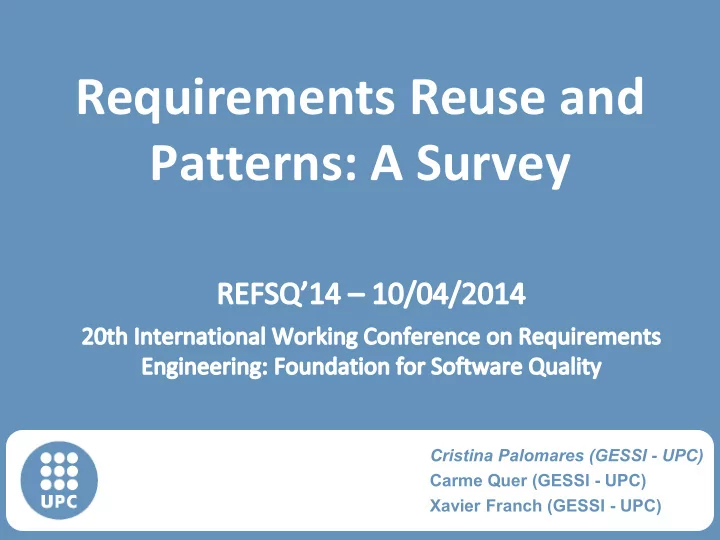

Requirements Reuse and Patterns: A Survey GESSI Cristina Palomares (GESSI - UPC) Carme Quer (GESSI - UPC) Xavier Franch (GESSI - UPC) Software Engineering for Information Systems Group
Outline Requirements Reuse and Patterns: A Survey 1. Context 2. Research Method 3. Survey Results 4. Validity 5. Conclusions & Future work 2
Context Requirements Reuse and Patterns: A Survey PABRE Framework PABRE Framework ( PA tterns B ased R equirements E licitation) ( PA tterns B ased R equirements E licitation) Created by: Created by: SRP SRP • GESSI@UPC • GESSI@UPC Heavily relies on Heavily relies on (Software (Software (Spain) (Spain) Requirement Requirement empirical work empirical work • SSI@TUDOR • SSI@TUDOR Patterns) Patterns) (Luxembourg) (Luxembourg) Survey 1) Requirements reuse state of the practice 2) PABRE requirement patterns opinion 3
Research Method Requirements Reuse and Patterns: A Survey Research Questions Design RQ1 • Is requirements reuse a usual practice in • 8 sections current RE processes? • 33 questions • Which benefits and drawbacks can appear RQ2 from the use of a catalogue of SRP? Data Data Channel Points Analysis • Practitioners • Online • Descriptive statistics • Started at REFSQ’13 • Researchers with RE indus- • Content • Open to RE commu- trial experience analysis nity afterwards 4
Survey Results Requirements Reuse and Patterns: A Survey • Preliminary results analysis • 50 completed responses… • … coming from 19 countries… Europe 21 participants (42%) North America 15 participants (30%) Researchers with Requirement • …and most of them with LIMITED EXPERIENCE as Engineers in Requirements Engineers INDUSTRY significant RE industrial experience 13 (26%) 27 (54%) 10 (20%) Researchers with SIGNIFICANT EXPERIENCE 5 as Requirements Engineers
Survey Results: RQ1 (i) Requirements Reuse and Patterns: A Survey RQ1: Is requirements reuse a usual practice in RE processes? RQ1: Is requirements reuse a usual practice in RE processes? Requirements Reuse Level Requirements Reuse Techniques Requirements reuse level 23 Not able to answer Very High 21 25 (60%) 2 (4%) 1 (2%) 19 (55%) (50%) 20 15 Inexistent (39%) High or Very Low 15 9 (18%) 11 (22%) 10 5 (13%) Medium 5 9 (18%) Low 0 18 (36%) 38 Copy & Copy & Duplicate Fill in Use of paste of paste of of a full predefined req. (76%) individual groups reqs. templates patterns reqs. of reqs. specifica- catalogue 6 tion
Survey Results: RQ1 (ii) Requirements Reuse and Patterns: A Survey RQ1: Is requirements reuse a usual practice in RE processes? RQ1: Is requirements reuse a usual practice in RE processes? Requirements Types more Similar between Projects 4. Usability 5. Reliability 6. Security 7. Maintainability Functional 2. Performance Efficiency Requirement Types 11. Business Suitability Non-Functional Requirement Types 12. Project Suitability Non-Technical 3. Compatibility Requirement Types 8. Portability 1. Functionality Suitability 10. Product non-Technical Suitability 9. Supplier Suitability 7
Survey Results: RQ2 (i) Requirements Reuse and Patterns: A Survey RQ2: Which benefits and drawbacks can appear from the use RQ2: Which benefits and drawbacks can appear from the use of a catalogue of SRP? of a catalogue of SRP? Problems ameliorated by using a SRP catalogue Lack of requirements uniformity Incompleteness of requirements specification Requirements ambiguity Too little time invested in requirements elicitation Requirements non-verifiable Too much time spent in requirements elicitation Stakeholders do not know exactly their needs Stakeholders needs’ change during the elicitation process Requirements inconsistency Lack of requirements. traceability Lack of requirements quantification Lack of requirements prioritization 8 Conflicts among needs stated by stakeholders
Survey Results: RQ2 (ii) Requirements Reuse and Patterns: A Survey RQ2: Which benefits and drawbacks can appear from the use RQ2: Which benefits and drawbacks can appear from the use of a catalogue of SRP? of a catalogue of SRP? Critical factors for introducing Barriers to adopt successfully a SRP catalogue a SRP catalogue Resistance of req. engineers to change Well-defined use method Integration of the catalogue with the Tool support existing req. engineering processes Community of users existence Risk of converting requirements elicitation in a stiff process Training courses Amount of reusable knowledge Help desk necessary to create and maintain • Ready-to-use SRP catalogue • Free trials periods • Lack of management support • Success cases 9
Validity Requirements Reuse and Patterns: A Survey • Questionnaire design: avoid errors and misunderstandings Glossary Open-text fields Pilots • Low response-rate Engage participants • Sampling validity Random sampling • Results generalization 10
Conclusions & Future Work Requirements Reuse and Patterns: A Survey • Requirements reuse is not a widespread practice • SRP could help to ameliorate common problems in requirements specifications Lack of uniformity, Incompleteness, Ambiguity • Critical aspects for adopting SRPs Staff and management support Well-defined method Tool support • Future work More responses Analyse pure researchers’ answers Correlation and cluster analysis 11
Requirements Reuse and Patterns: A Survey GESSI Cristina Palomares (GESSI - UPC) Carme Quer (GESSI - UPC) Xavier Franch (GESSI - UPC) Software Engineering for Information Systems Group
Recommend
More recommend